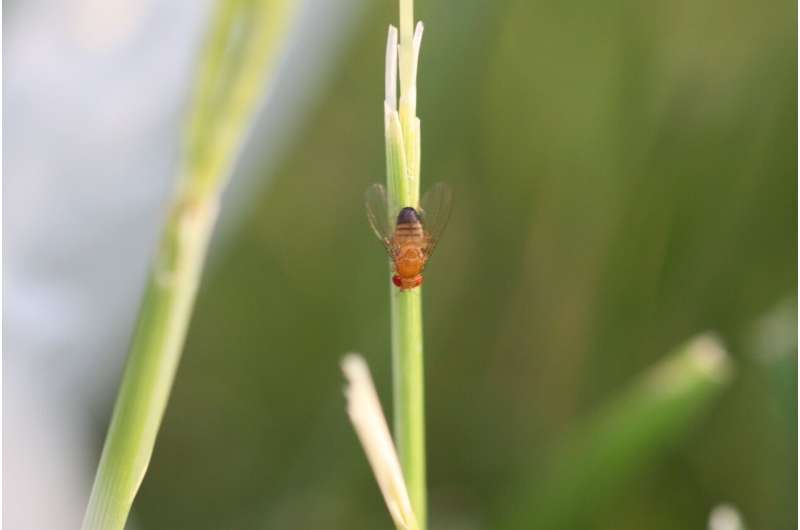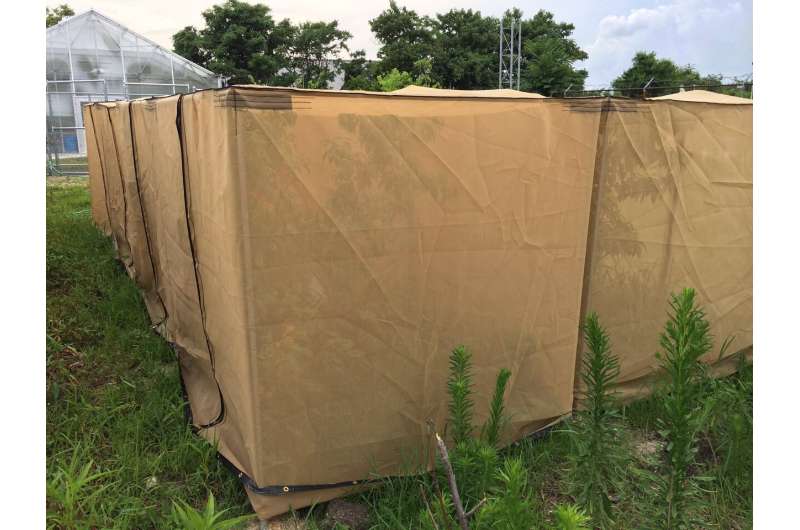Fruit flies' microbiomes shape their evolution

The expression "you are what you eat" has taken on new meaning. In an experiment in fruit flies, or Drosophila melanogaster, researchers at the University of Pennsylvania have found that adding different species of microbes to the flies' food caused populations to diverge genetically, racking up significant genomic changes in just five generations.
"Our work is very suggestive that microbial community composition drives, at least in part, how the organisms in which they live are evolving," says Paul Schmidt, a biologist at Penn and senior author on the work, which appears in the journal PNAS. "The fact that we can see this effect in experiments done over such a short time scale suggests that the magnitude of the fitness effects the microbes have is incredible."
Unlike a laboratory experiment, where every possible aspect of the environment is controlled, from the genetics of the flies themselves to the temperature and diet, in order to magnify differences between treatments this set of experiments took place outdoors, at Pennovation Works on Penn's campus. The setting more closely mirrors nature, subject to weather, seasonal changes, even the odd spider or fleck of dirt intruding in the enclosures.
The fact that, despite the potential influences of these outside factors, the researchers still found the microbiome shifts to have a significant effect on the genomes of fly populations, makes the finding even more compelling, Schmidt says.
"I think it's fair to say we preserved as much ecological realism as we could at the expense of detecting large effects," he says. "We just shifted the relative abundance of these microbes in the flies' diet, and that was enough to see an effect."
Schmidt and postdoctoral fellow Seth Rudman, the lead author on the paper, took advantage of the fact that flies have relatively simple microbiome communities compared to other organisms, such as humans.
"If you do a survey of a mammalian microbiome, many of the bacteria you find in the gut are unknown," says Rudman. "But that's not the case with flies. It just happens that Drosophila have only about 100 species in their microbiome community."
Other benefits of fruit flies for this type of study include their short generation time—one can study several generations in a matter of months—and the fact that they can be reared to extremely high population sizes. In this case, that meant hundreds of thousands of flies in each experiment.

From earlier work, scientists had an inkling that the microbiome was linked to changes in the fitness of the fly. Flies from more northern latitudes tend to have more Lactobacillus bacteria as part of their microbiome, and also live longer, have fewer eggs and are more tolerant to stress. More southerly populations, on the other hand, which tend to have more of the bacteria Acetobacter, had shorter lifespans, more eggs, and were less stress-tolerant. Work in the lab showed that exposing flies to these two types of bacteria elicited these same traits.
But could the microbes drive the evolution of whole populations of flies? To test that, Schmidt, Rudman, and colleagues designed an experimental setup to manipulate the flies' microbiomes. They introduced a thousand flies into each of several outdoor mesh enclosures, 2 cubic meters in size and adorned with groundcover and a peach tree. They varied the food in some of the enclosures, supplementing it with either Acetobacter or Lactobacillus.
The researchers confirmed that the feeding altered the microbiomes of the flies, though just slightly. That was enough, however, to affect their genes. Comparing the genomes of the flies at the start of the study to the conclusion, after five generations, the team could pick out distinct changes in the frequency of certain alleles—one variant of a gene—that were consistent with what has been seen in natural populations of flies.
"We found that the allele that was more common in the Lactobacillus solution cages was also the allele that's more common in the north, where Lactobacillus itself is more common," says Rudman. "And the allele that was more common in the Acetobacter cages was also the allele that is more common in the south, where Acetobacter is more common."
To the researchers, that finding hammered home the significance of the microbes' influence.
"The bottom line is, microbes drive rapid adaptation," Schmidt says.
Whether that effect translates to humans and other animals is a matter for further study, the authors say, but numerous studies have underscored the potent effect of the microbiome.
In future work, the researchers will be flipping the script, testing to see whether changes in the flies' genetic profiles influence which microbes can gain a foothold in their microbiomes. And they'll also probe more deeply into determining precisely how the changing microbiome affects its host.
More information: Seth M. Rudman et al, Microbiome composition shapes rapid genomic adaptation of Drosophila melanogaster, Proceedings of the National Academy of Sciences (2019). DOI: 10.1073/pnas.1907787116
Journal information: Proceedings of the National Academy of Sciences
Provided by University of Pennsylvania


















